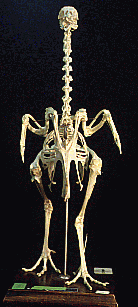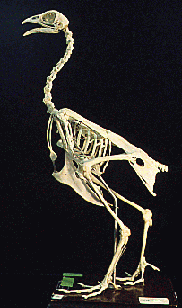



Aves: More on Morphology

|

|
Click on either picture to view an enlargement.





|

|
The furcula, a fused clavicle (collarbone), serves as a brace during the flight stroke; it's visible in the pictures above as a large Y-shaped bone ahead of the sternum. The clavicle is also found in non-avian dromaeosaurian dinosaurs, and was probably co-opted in function from the dromaeosaurian function of providing a brace for the shoulder girdle while holding prey. Crucial for bird flight is a canal formed by the articulation of the humerus (forewing bone), the scapula (shoulder blade), and the coracoid (bone connecting the sternum itself to the humerus). Through this canal, the foramen triosseum or triosseal canal, runs the tendon of the supracoracoideus muscle, which attaches to the sternum and the dorsal side of the humerus, and lifts the wing upwards in flight. The powerful downstroke of the wing is powered by the large pectoralis muscles, which also attach to the sternal keel.
A number of other features of birds have the effect of reducing weight or otherwise contributing to flight capabilities. Birds have highly shortened tails, which effectively reduce the bird's weight (compare Archaeopteryx, which had a long bony tail). Living birds lack teeth, and the jaws are covered by a horny beak. Bird bones are hollow and filled with extensions of the body's air sacs, which are extensions of the lungs that allow for increased respiratory efficiency. The hollow bones are thin-walled, but actually quite resistant to stress from bending -- the stresses involved in flight. The eyes are large and the visual cortex of the brain is well-developed. Other anatomical features of birds that are probably connected with flight are not visible in the skeleton. Birds lack a bladder, and they excrete uric acid in the form of solid white crystals, rather than urea in a water solution.

For a short lesson on external bird anatomy, try this tutorial.

